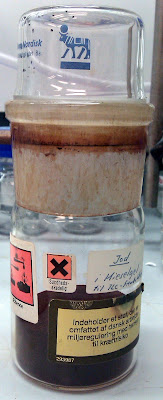
The iodine stain is by far the easiest stain to prepare and use. The classic way is to simply have a chamber with some iodine crystals that you put your TLC plate into. The iodine vapours will react with many functional groups but is particularly good with unsaturated compounds (e.g. alkenes and alkynes) to give reddish brown spots (see TLC plate below). Another way to prepare the iodine stain is to mix silica gel with iodine crystals (see pic to the right). Stick the TLC plate into the red silica and wait a few minutes to develop your plate. This approach is a bit gentler and in my experience gives a better result. If you want to keep your TLC result for later remember to take a picture of your plate or circle the spots as they fade relatively fast. D!




 orcid.org/0000-0003-3926-7047
orcid.org/0000-0003-3926-7047


